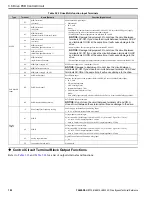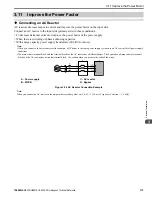
3.13 Motor Application Precautions
116
YASKAWA
SIEPYAIH6B01A HV600 AC Drive Bypass Technical Reference
■
Audible Noise
The audible noise of the motor changes when the carrier frequency setting changes. When you use a high carrier
frequency, audible noise from the motor is equivalent to the motor noise generated when you operate from line power.
If you operate at speeds that are more than the rated rotation speed, the unwanted motor noise increases.
◆
Precautions for Specialized Motors
■
Pole Change Motors
The rated current of pole change motors is different than standard motors. Check the maximum current of the motor
before you select a drive. Always stop the motor before you switch between the number of motor poles. If you change
the number of poles while the motor is rotating, the overvoltage from regeneration or the overcurrent protection
circuitry will make the motor coast to stop.
■
Submersible Motors
The rated current of a submersible motor is more than the rated current of a standard motor. Use a sufficiently large
motor cable that will not let voltage drop decrease the maximum torque level.
■
Explosion-Proof Motors
You must test the motor and the drive together for explosion-proof certification. You must also test existing
installations of explosion-proof motors. The drive is not designed for explosion-proof areas. Install the drive in a safe
location.
The encoder used with pressure-resistant explosion-proof motors is intrinsically safe. When wiring between the drive
and encoder, always connect through a specialized pulse coupler.
■
Geared Motors
The continuous speed range is different for different lubricating methods and manufacturers. For oil lubrication,
continuous operation in the low-speed range can cause burnout. Contact the manufacturer for more information about
applications where operating at more than the rated frequency is necessary.
■
Single-Phase Motors
Variable speed drives are not designed to operate with single-phase motors. The drive is for use with three-phase
motors only. If you use capacitors to start the motor, it can cause a high frequency current to flow to the capacitors
and can damage the capacitors. A split-phase start or a repulsion start can burn out the starter coils because the
internal centrifugal switch is not activated.
■
Motors with Brakes
If you use a drive to operate a motor that has a brake connected to the output side, low voltage levels can cause the
brake to possibly not release at start. Use a motor with a brake that has a dedicated source of power for the brake.
Connect the brake power supply to the power supply side of the drive. Motors with built-in brakes make noise when
operating at low speeds.
◆
Notes on the Power Transmission Mechanism
For power transmission machinery that uses oil to lubricate gearboxes, transmissions, or reduction gears, make sure
that you use precaution if you operate the machinery continuously at low speed. Oil does not lubricate the system as
well at low speeds. If you operate at frequencies higher than the rated frequency, it can cause problems with the power
transmission mechanism. These problems include audible noise, decreased service life, and decreased durability.
Summary of Contents for H6B1A002
Page 12: ...12 YASKAWA SIEPYAIH6B01A HV600 AC Drive Bypass Technical Reference...
Page 74: ...Page Intentionally Blank...
Page 76: ...Page Intentionally Blank...
Page 454: ...5 14 Z Bypass Parameters 454 YASKAWA SIEPYAIH6B01A HV600 AC Drive Bypass Technical Reference...
Page 590: ...8 6 Storage Guidelines 590 YASKAWA SIEPYAIH6B01A HV600 AC Drive Bypass Technical Reference...
Page 780: ...11 3 European Standards 780 YASKAWA SIEPYAIH6B01A HV600 AC Drive Bypass Technical Reference...
















































